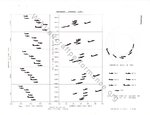Francis marliere
Airman
- 72
- Aug 9, 2004
Gentlemen,
I have just finished Eric brown's "Duels in the Sky" and I am surprised by some of the comments he made.
He quotes some planes with rate of climb that are not coherent with other sources and 'conventional wisdom' (4.000 fpm for A6M2 and D.520, 3.300 fpm for Wildcat II, 2.400 for F4U-1, etc.).
He also says :
"In a dive, the Wildcat and the Zeke were virtually equal"
"Both (F6F-3 and Fw 190) were very maneuvrable"
I don't understand : I know that Fw 190 has an outstanding roll of rate but the Hellcat is neither a first class roller or turner.
The Ki.61 "handled like the Hurricane"
The Tony is most commonly described to be like a P-40 or Me 109 (not a first class turner but a good diver).
The Mustang "had a rate of roll bettered only by that of the Fw 190". Commonly this is rather said of the P-47 (or F4U, P-40) not the P-51.
The Hurricane has superior rate of roll and acceleration in the dive than the F4F-4. The Wildcat has stepper angle of climb than the Hurricane.
I thought that the Hurricane is neither a great roller nor a great diver but climbs better than the Wildcat.
Well I don't know what to think about. I one hand, all that appear surprisingly strange, but in another hand, I guess that someone such as Eric Brown knows what he is talking about.
What is your opinion ?
Best regards,
Francis
I have just finished Eric brown's "Duels in the Sky" and I am surprised by some of the comments he made.
He quotes some planes with rate of climb that are not coherent with other sources and 'conventional wisdom' (4.000 fpm for A6M2 and D.520, 3.300 fpm for Wildcat II, 2.400 for F4U-1, etc.).
He also says :
"In a dive, the Wildcat and the Zeke were virtually equal"
"Both (F6F-3 and Fw 190) were very maneuvrable"
I don't understand : I know that Fw 190 has an outstanding roll of rate but the Hellcat is neither a first class roller or turner.
The Ki.61 "handled like the Hurricane"
The Tony is most commonly described to be like a P-40 or Me 109 (not a first class turner but a good diver).
The Mustang "had a rate of roll bettered only by that of the Fw 190". Commonly this is rather said of the P-47 (or F4U, P-40) not the P-51.
The Hurricane has superior rate of roll and acceleration in the dive than the F4F-4. The Wildcat has stepper angle of climb than the Hurricane.
I thought that the Hurricane is neither a great roller nor a great diver but climbs better than the Wildcat.
Well I don't know what to think about. I one hand, all that appear surprisingly strange, but in another hand, I guess that someone such as Eric Brown knows what he is talking about.
What is your opinion ?
Best regards,
Francis

